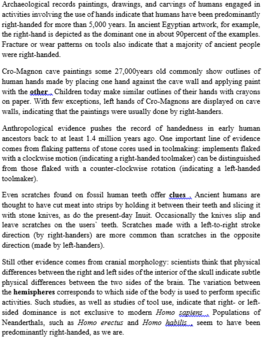Read the following passage and mark the letter A, B, C, or D on your answer sheet to indicate the correct answer to each of the questions from 36 to 42.
It is estimated that over 99 percent of all species that ever existed have become extinct. What causes extinction? When a species is no longer adapted to a changed environment, it may perish. The exact causes of a species’ death vary from situation to situation. Rapid ecological change may render an environment hostile to a species. For example, temperatures may change and a species may not be able to adapt. Food Resources may be affected by environmental changes, which will then cause problems for a species requiring these resources. Other species may become better adapted to an environment, resulting in competition and, ultimately, in the death of a species.
The fossil record reveals that extinction has occurred throughout the history of Earth. Recent analyses have also revealed that on some occasions many species became extinct at the same time – a mass extinction. One of the best-known examples of mass extinction occurred 65 million years ago with the demise of dinosaurs and many other forms of life. Perhaps the largest mass extinction was the one that occurred 225 million years ago. When approximately 95 percent of all species died, mass extinctions can be caused by a relatively rapid change in the environment and can be worsened by the close interrelationship of many species. If, for example, something were to happen to destroy much of the plankton in the oceans, then the oxygen content of Earth would drop, affection even organisms not living in the oceans. Such a change would probably lead to a mass extinction.
One interesting, and controversial, finding is that extinctions during the past 250 million years have tended to be more intense every 26 million years. This periodic extinction might be due to intersection of the Earth’s orbit with a cloud of comets, but this theory is purely speculative. Some researchers have also speculated that extinction may often be random. That is, certain species may be eliminated and others may survive for no particular reason. A species’ survival may have nothing to do with its ability or inability to adapt. If so, some of evolutionary history may reflect a sequence of essentially random events
In paragraph 3, the author makes which of the following statements about a species’ survival?
A. It reflects the interrelationship of many species
B. It may depend on chance events
C. It does not vary greatly from species to species
D. It is associated with astronomical conditions








Đáp án B
Ở đoạn 3, tác giả đã nói gì về sự sống sót của một loài
A. Nó phản ánh mối quan hệ liên quan lẫn nhau giữa nhiều loài động vật
B. Nó có thể phụ thuộc vào những việc xảy ra tình cờ
C. Nó không khác nhau nhiều giữa các loài
D. Nó gắn liền với điều kiện thiên văn
Giải thích: Ở đoạn 3, tác gỉa có nhăc đến suy đoán “Sự tuyệt chủng là ngẫu nhiên”. Dẫn chứng ở “Some researchers have also speculated that extinction may often be random. That is, certain species may be eliminated and others may survive for no particular reason. A species’ survival may have nothing to do with its ability or inability to adapt. If so, some of evolutionary history may reflect a sequence of essentially random events.” (Một số nhà nghiên cứu cũng đã cho rằng sự tuyệt chủng thường là ngẫu nhiên. Nghĩa là một số loài bị loại bỏ và những loài khác có thể tiếp tục tồn tại mà không có lí do cụ thể nào. Sự tồn tại của một số loài có thể không liên quan gì đến khả năng thích nghi hay không thích nghi của chúng. Nếu vậy, một vài sự tiến hóa lịch sử có thể phản ảnh một chuỗi các sự kiện ngẫu nhiên quan trọng.)